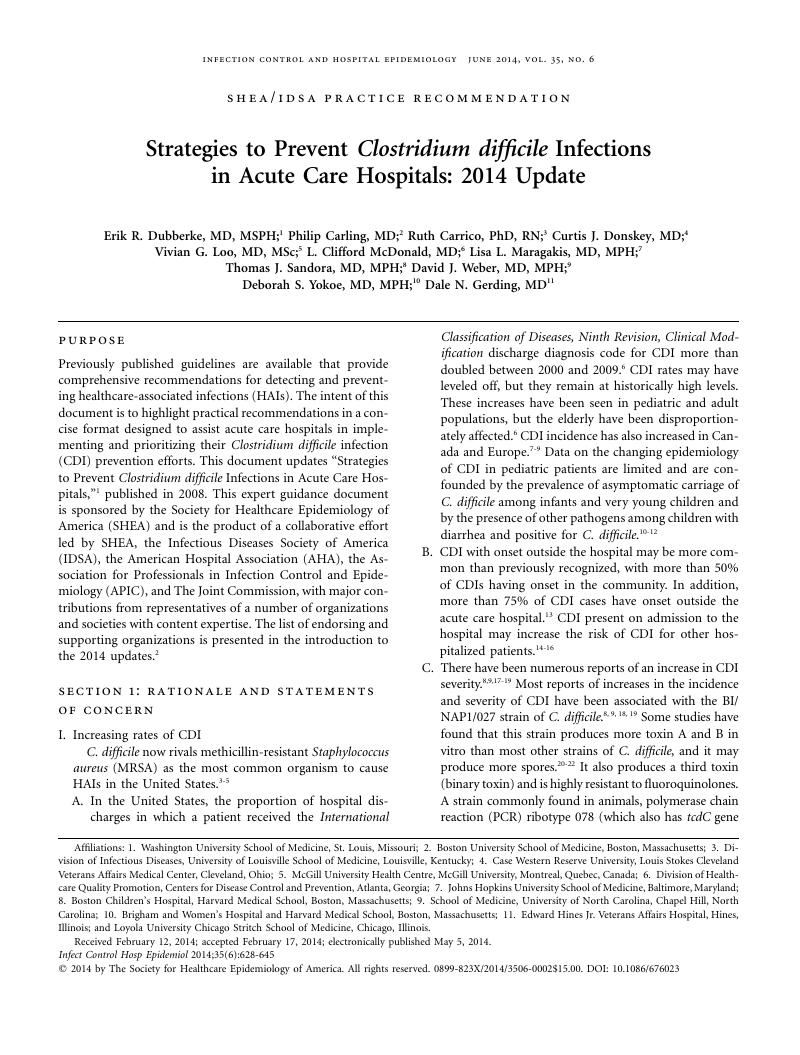Crossref Citations
This article has been cited by the following publications. This list is generated based on data provided by Crossref.
Yokoe, Deborah S.
Anderson, Deverick J.
Berenholtz, Sean M.
Calfee, David P.
Dubberke, Erik R.
Eilingson, Katherine D.
Gerding, Dale N.
Haas, Janet P.
Kaye, Keith S.
Klompas, Michael
Lo, Evelyn
Marschall, Jonas
Mermel, Leonard A.
Nicolle, Lindsay E.
Salgado, Cassandra D.
Bryant, Kristina
Classen, David
Crist, Katrina
Deloney, Valerie M.
Fishman, Neil O.
Foster, Nancy
Goldmann, Donald A.
Humphreys, Eve
Jernigan, John A.
Padberg, Jennifer
Perl, Trish M.
Podgorny, Kelly
Septimus, Edward J.
VanAmringe, Margaret
Weaver, Tom
Weinstein, Robert A.
Wise, Robert
and
Maragakis, Lisa L.
2014.
A Compendium of Strategies to Prevent Healthcare-Associated Infections in Acute Care Hospitals: 2014 Updates.
Infection Control & Hospital Epidemiology,
Vol. 35,
Issue. S2,
p.
S21.
Otter, J.A.
2014.
Journal Roundup.
Journal of Hospital Infection,
Vol. 87,
Issue. 4,
p.
249.
Yokoe, Deborah S.
Anderson, Deverick J.
Berenholtz, Sean M.
Calfee, David P.
Dubberke, Erik R.
Ellingson, Katherine D.
Gerding, Dale N.
Haas, Janet P.
Kaye, Keith S.
Klompas, Michael
Lo, Evelyn
Marschall, Jonas
Mermel, Leonard A.
Nicolle, Lindsay E.
Salgado, Cassandra D.
Bryant, Kristina
Classen, David
Crist, Katrina
Deloney, Valerie M.
Fishman, Neil O.
Foster, Nancy
Goldmann, Donald A.
Humphreys, Eve
Jernigan, John A.
Padberg, Jennifer
Perl, Trish M.
Podgorny, Kelly
Septimus, Edward J.
VanAmringe, Margaret
Weaver, Tom
Weinstein, Robert A.
Wise, Robert
and
Maragakis, Lisa L.
2014.
A Compendium of Strategies to Prevent Healthcare-Associated Infections in Acute Care Hospitals: 2014 Updates.
Infection Control & Hospital Epidemiology,
Vol. 35,
Issue. 8,
p.
967.
Pakyz, Amy L.
Patterson, Julie A.
Motzkus-Feagans, Christine
Hohmann, Samuel F.
Edmond, Michael B.
and
Lapane, Kate L.
2015.
Performance of the Present-on-Admission Indicator for Clostridium difficile Infection.
Infection Control & Hospital Epidemiology,
Vol. 36,
Issue. 7,
p.
838.
Barbut, F.
2015.
How to eradicate Clostridium difficile from the environment.
Journal of Hospital Infection,
Vol. 89,
Issue. 4,
p.
287.
von Müller, Lutz
Mock, Markus
Halfmann, Alexander
Stahlmann, Julia
Simon, Arne
and
Herrmann, Mathias
2015.
Epidemiology of Clostridium difficile in Germany based on a single center long-term surveillance and German-wide genotyping of recent isolates provided to the advisory laboratory for diagnostic reasons.
International Journal of Medical Microbiology,
Vol. 305,
Issue. 7,
p.
807.
Pugh, Richard
Grant, Chris
Cooke, Richard PD
and
Dempsey, Ged
2015.
Short-course versus prolonged-course antibiotic therapy for hospital-acquired pneumonia in critically ill adults.
Cochrane Database of Systematic Reviews,
Weichert, S.
Simon, A.
von Müller, L.
Adam, R.
and
Schroten, H.
2015.
Clostridium-difficile-assoziierte Infektionen im Kindes- und Jugendalter.
Monatsschrift Kinderheilkunde,
Vol. 163,
Issue. 5,
p.
427.
Saint, Sanjay
Fowler, Karen E.
Krein, Sarah L.
Ratz, David
Flanders, Scott A.
Dubberke, Erik R.
and
Greene, M. Todd
2015.
Clostridium Difficile Infection in the United States: A National Study Assessing Preventive Practices Used and Perceptions of Practice Evidence.
Infection Control & Hospital Epidemiology,
Vol. 36,
Issue. 8,
p.
969.
Loo, Vivian G.
2015.
Environmental Interventions to Control Clostridium difficile.
Infectious Disease Clinics of North America,
Vol. 29,
Issue. 1,
p.
83.
Gould, Carolyn V.
File, Thomas M.
and
McDonald, L. Clifford
2015.
Causes, Burden, and Prevention of Clostridium difficile Infection.
Infectious Diseases in Clinical Practice,
Vol. 23,
Issue. 6,
p.
281.
Jump, Robin L. P.
and
Donskey, Curtis J.
2015.
Clostridium difficile in the Long-Term Care Facility: Prevention and Management.
Current Geriatrics Reports,
Vol. 4,
Issue. 1,
p.
60.
Wilcox, M. H.
Vehreschild, M. J. G. T.
and
Nord, C. E.
2015.
Annual Update in Intensive Care and Emergency Medicine 2015.
Vol. 2015,
Issue. ,
p.
25.
Cassir, Nadim
Delarozière, Jean-Christophe
Dubourg, Gregory
Delord, Marion
Lagier, Jean-Christophe
Brouqui, Phillipe
Fenollar, Florence
Raoult, Didier
and
Fournier, Pierre Edouard
2016.
A Regional Outbreak of Clostridium difficile PCR-Ribotype 027 Infections in Southeastern France from a Single Long-Term Care Facility.
Infection Control & Hospital Epidemiology,
Vol. 37,
Issue. 11,
p.
1337.
Banach, David B.
Seville, Maria Teresa A.
and
Kusne, Shimon
2016.
Transplant Infections.
p.
843.
Beaulac, Kirthana
Corcione, Silvia
Epstein, Lauren
Davidson, Lisa E.
and
Doron, Shira
2016.
Antimicrobial Stewardship in a Long-Term Acute Care Hospital Using Offsite Electronic Medical Record Audit.
Infection Control & Hospital Epidemiology,
Vol. 37,
Issue. 4,
p.
433.
Kelly, Sean G.
Yarrington, Michael
Zembower, Teresa R.
Sutton, Sarah H.
Silkaitis, Christina
Postelnick, Michael
Mikolajczak, Anessa
and
Bolon, Maureen K.
2016.
InappropriateClostridium difficileTesting and Consequent Overtreatment and Inaccurate Publicly Reported Metrics.
Infection Control & Hospital Epidemiology,
Vol. 37,
Issue. 12,
p.
1395.
Bernstein, Daniel A.
Salsgiver, Elizabeth
Simon, Matthew S.
Greendyke, William
Eiras, Daniel P.
Ito, Masahiro
Caruso, Dean A.
Woodward, Timothy M.
Perriel, Odette T.
Saiman, Lisa
Furuya, E. Yoko
and
Calfee, David P.
2016.
Understanding Barriers to Optimal Cleaning and Disinfection in Hospitals: A Knowledge, Attitudes, and Practices Survey of Environmental Services Workers.
Infection Control & Hospital Epidemiology,
Vol. 37,
Issue. 12,
p.
1492.
Shrestha, Subarna K.
Sunkesula, Venkata C.K.
Kundrapu, Sirisha
Tomas, Myreen E.
Nerandzic, Michelle M.
and
Donskey, Curtis J.
2016.
Acquisition of Clostridium difficile on Hands of Healthcare Personnel Caring for Patients with Resolved C. difficile Infection.
Infection Control & Hospital Epidemiology,
Vol. 37,
Issue. 4,
p.
475.
Kim, Young Ah
Rim, John Hoon
Choi, Min Hyuk
Kim, Heejung
and
Lee, Kyungwon
2016.
Increase of Clostridium difficile in Community; Another Worrisome Burden for Public Health.
Annals of Clinical Microbiology,
Vol. 19,
Issue. 1,
p.
7.



